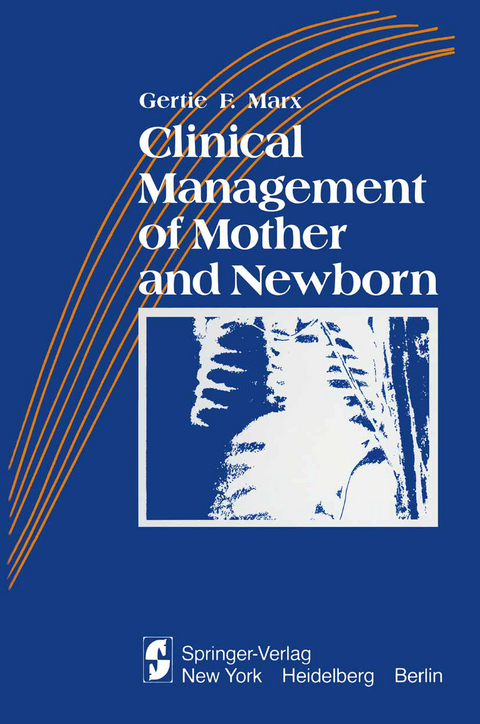
Clinical Management of Mother and Newborn
Springer-Verlag New York Inc.
978-1-4612-6175-9 (ISBN)
The birth of a baby is the culmination of months of anticipation and plan ning. Most often, mother and infant are healthy and readily able to estab lish close contact-a bond. However, in some situations either mother or baby or both present complications. The more prompt and rational the treatment, the sooner the normal parent-infant relationship will commence. This book is devoted exclusively to the first days following birth. In its 15 chapters, postpartum and postnatal physiology and pathophy[ i:.;logy are reviewed by 18 specialists. Normal and abnormal development of mother and child is correlated with proven means of clinical management. Chapters 1 through 3 cover maternal postpartum developments and complications. Chapter 4 stresses the importance of a normal parent newborn relationship, a concept of increasing concern in modern society. The following ten chapters discuss neonatal physiology and pathophysi ology; the effects of obstetric anesthesia on infant behavior, pulmonary function measurements in the postnatal period and treatment of the sick newborn are discussed in detail. The final chapter reviews maternal and perinatal mortality; the data, based on extensive surveys in New York City, indicate that current management is effecting an overall decline in mortality.
1 Postpartum Uterine Activity and Anesthesia.- Uterine Muscle Physiology.- Methods of Intrauterine Pressure Measurement.- Uterine Activity During Pregnancy.- Analysis of Uterine Activity.- Effects of Oxytocin and Anesthetic Agents.- Conclusion.- References.- 2 Pathophysiology and Therapy of Postpartum Complications.- Obstetric Complications.- Iatrogenic Complications.- Complications from Coincidental Medical Disease.- Conclusion.- References.- 3 Headache in the Postpartum Period.- Anesthesia-Related Headaches.- Non-Anesthesia-Related Headaches.- Conclusion.- References.- 4 The Normal Parent-Newborn Relationship: Its Importance for the Healthy Development of the Child.- Maternal Deprivation.- Systematic Studies on Large Samples.- The Content of the Parent-Newborn Relationship.- Theoretical Considerations.- The Dimersions of the Caregiver-Neonate Relationship.- Conclusion.- References.- 5 Reflections of the Apgar Scoring System.- Resuscitation.- Individual Components of the Score.- The Time Factor.- Prognostic Value.- Summary.- References.- 6 Clinical Neonatal Neurobehavioral Assessment: Methods and Significance.- Scoring the Early Neonatal Neurobehavioral Scale.- Methodologie Issues.- Clinical Uses of the Early Neonatal Neurobehavioral Examination.- Acknowledgments.- References.- 7 Effects of Obstetric Analgesia-Anesthesia on Neonatal Neurobehavior.- Wakefulness.- Electroencephalography.- Attentiveness.- Sucking.- Habituation.- Brazelton Neurobehavioral Scale.- Scanlon’s Early Neonatal Neurobehavioral Scale.- Other Neurobehavioral Scales.- Parental-Neonate Interaction.- Discussion.- References.- 8Drug Sensitivity of the Neonate.- Drug Absorption.- Drug Distribution.- Drug Metabolism.- Drug Elimination.- Receptor Sensitivity.- Conclusion.- References.- 9 PulmonaryFunction in the Perinatal Period.- The Prenatal Lung (Liquid Lung).- The First Breaths (Foam Lung).- The Neonatal Lung (Air Lung).- References.- 10 The Meconium Aspiration Syndrome.- Incidence.- Pathophysiology.- Clinical Presentation.- Radiographic Features.- Management Considerations.- Prognosis.- References.- 11 Treatment of Neonatal Metabolic Acidosis.- Acid Base Regulatory Mechanisms.- Neonatal Limitations.- Clinical Conditions.- Normal Labor and Delivery.- Perinatal Asphyxia.- Respiratory Distress Syndrome.- Blood Transfusions.- Hypothermia.- Consequences of Acidosis.- Treatment of Acidosis.- THAM.- Asphyxia Neonatorum.- Respiratory Distress Syndrome.- Blood Transfusions.- Conclusion.- References.- 12 Respirator Treatment of the Neonate.- General Principles of Respiratory Support.- Techniques of Supporting Ventilation.- Conclusion.- References.- 13 Exchange Transfusion of the Newborn Infast Ermelando.- Indications for ET.- Laboratory Determinations.- Criteria for ET and Basic Management.- Conduct of ET.- Selection of Donor Blood.- Potential Hazards of ET.- Conclusion.- Acknowledgment.- References.- 14 The Newborn of the Drug-Dependent Mother.- Drugs and Pregnancy.- Fetal Growth and Development.- Transitional Period.- Neonatal Drug Withdrawal.- Management of Neonatal Drug Withdrawal.- Later Complications of Neonatal Drug Dependency.- Follow-up of Passively Addicted Infants.- Conclusion.- References.- 15 Maternal and Perinatal Mortality.- Methodology.- Results.- Conclusion.- Recommended Standards for Obstetric Anesthetic Care.- References.
| Zusatzinfo | XIV, 274 p. |
|---|---|
| Verlagsort | New York, NY |
| Sprache | englisch |
| Maße | 152 x 229 mm |
| Themenwelt | Sachbuch/Ratgeber ► Natur / Technik ► Garten |
| Medizin / Pharmazie ► Gesundheitsfachberufe ► Hebamme / Entbindungspfleger | |
| Medizin / Pharmazie ► Gesundheitswesen | |
| Medizin / Pharmazie ► Medizinische Fachgebiete ► Gynäkologie / Geburtshilfe | |
| Medizin / Pharmazie ► Medizinische Fachgebiete ► Notfallmedizin | |
| Schlagworte | Perinatale Medizin |
| ISBN-10 | 1-4612-6175-9 / 1461261759 |
| ISBN-13 | 978-1-4612-6175-9 / 9781461261759 |
| Zustand | Neuware |
| Haben Sie eine Frage zum Produkt? |
aus dem Bereich


